Ese avatar genérico de “persona misteriosa” en tu sección de comentarios de WordPress no le está haciendo ningún favor a tu sitio. Después de haber construido cientos de sitios de WordPress, sabemos cómo una sección de comentarios personalizada puede hacer que su sitio sea más atractivo y profesional.
Tanto si desea utilizar el logotipo de su marca, un diseño personalizado o simplemente algo más atractivo que la silueta gris por defecto, cambiar su gravatar por defecto es una forma sencilla de mejorar el aspecto de su sitio. ¿Y lo mejor? No necesitas ser un experto en tecnología para hacer este cambio.
En esta guía, le mostraremos varias formas de reemplazar el gravatar por defecto en WordPress
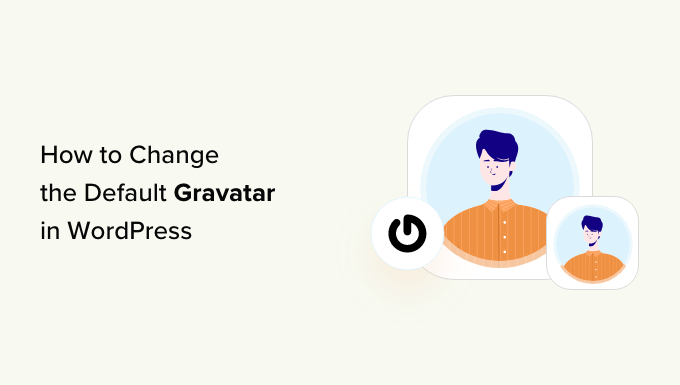
¿Qué es un Gravatar por defecto y por qué cambiarlo?
Gravatar son las siglas de Globally Recognized Avatar. Es un servicio web que permite a la gente crear un perfil y asociar imágenes de avatar a su dirección de correo electrónico.
Todos los sitios de WordPress son compatibles con gravatars y mostrarán automáticamente el avatar del usuario cuando escriba entradas en un blog de WordPress con varios autores o deje comentarios.
Si un usuario no tiene un gravatar, entonces WordPress mostrará un gravatar por defecto en su lugar. Para la mayoría de los sitios web de WordPress, se trata de una persona misteriosa gris.

Puede cambiar este gravatar por defecto por cualquier otra imagen de su elección. Por ejemplo, puede utilizar una imagen que represente a su empresa, como el logotipo de su sitio web. Esto puede ayudar a reforzar tu imagen de marca.
En nuestro caso, decidimos desactivar por completo los gravatares, ya que consideramos que crean un paso adicional innecesario para los usuarios que desean dejar comentarios.
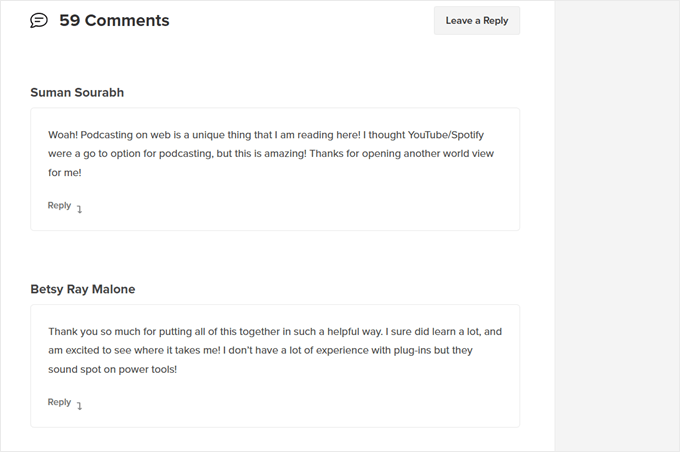
Dicho esto, veamos cómo puedes cambiar la imagen de gravatar por defecto en WordPress. Simplemente usa los enlaces rápidos para saltar directamente al método que quieras usar:
Método 1: Cambiar el Gravatar por defecto de WordPress (Rápido y Fácil)
WordPress viene con diferentes gravatares por defecto que puede utilizar. El uso de los valores por defecto es la forma más rápida de cambiar el gravatar de la persona misteriosa, aunque estas imágenes no serán únicas para su sitio web WordPress o marca.
Para ver los diferentes gravatars por defecto, debe ir a Ajustes ” Discusión desde el área de administración de WordPress.
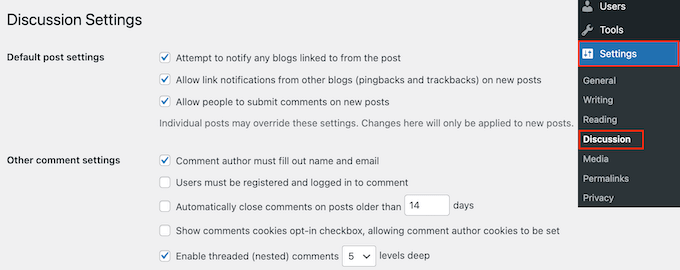
En ‘Avatar por defecto’, verá todas las imágenes de avatar de usuario diferentes que WordPress puede utilizar cuando no hay un gravatar enlazado a la dirección de correo electrónico de la persona.
Por defecto, WordPress utiliza la persona misteriosa, pero puede utilizar cualquier otra imagen en esta sección.
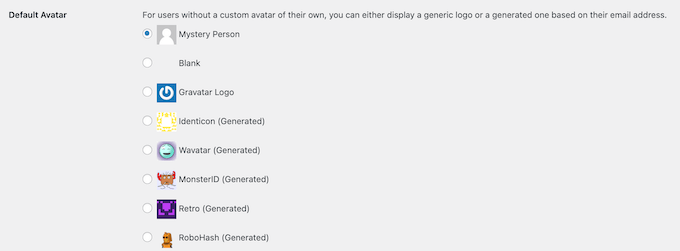
Sólo tiene que hacer clic en el botón de opción situado al lado de la imagen que desea utilizar en su blog de WordPress.
A continuación, desplácese hasta la parte inferior de la pantalla y haga clic en “Guardar cambios”.
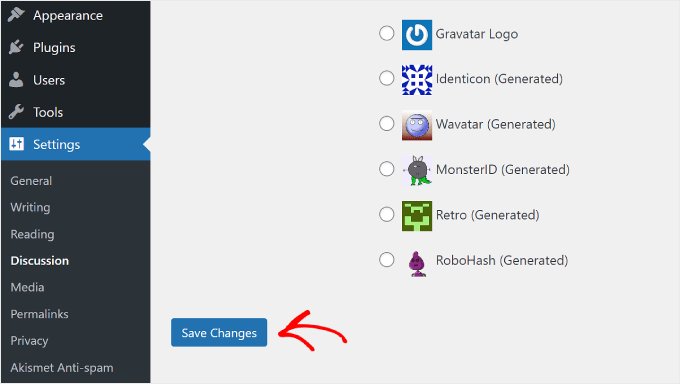
Método 2: Usar Thrive Comments para subir un Gravatar personalizado (Método Plugins)
Si no te gustan las imágenes de perfil de WordPress por defecto, entonces puedes subir un gravatar personalizado en su lugar. Esta es la mejor manera de personalizar tu sección de comentarios con tu marca.
Para este método, utilizaremos Thrive Comments. Es un plugin de comentarios que está diseñado para animar a los usuarios a comentar en las entradas de tu blog y aumentar la participación en tu sitio web.
Además de una característica de gravatar personalizado, Thrive Comments viene con herramientas para hacer su sección de comentarios más divertido y emocionante. Por ejemplo, puede activar gustos y disgustos como en un sitio de medios sociales.

Puedes conseguir Thrive Comments como plugin individual o comprar la solución completa Thrive Themes Suite. Esto incluye todos los productos de Thrive, como Thrive Ovations, que puede convertir tus comentarios en testimonios.
A continuación, puede descargar un paquete zip de plugins para instalarlo en su sitio de WordPress. Lee nuestra guía completa sobre cómo instalar un plugin de WordPress para obtener más información.
Con el plugin instalado y activado, puedes ir a Thrive Escritorio “ Thrive Comentarios desde el área de administrador de WordPress. A continuación, abre la pestaña “Personalizar estilo”.
Dentro de esta pestaña, asegúrate de que el ajuste “Mostrar avatares” está activado. Una vez hecho esto, haz clic en “Elegir imagen”.
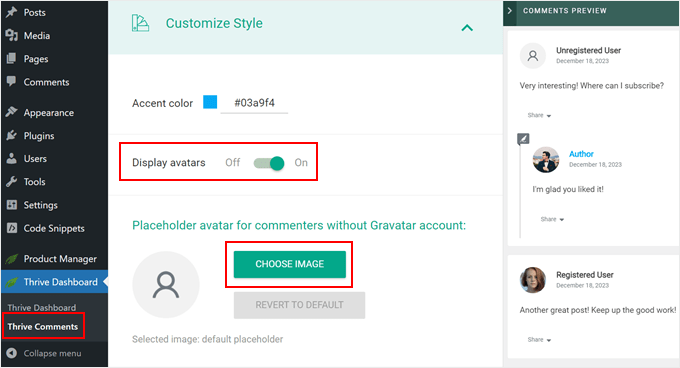
En este punto, puede elegir una imagen existente de la biblioteca de medios de WordPress o subir la suya propia para utilizarla como imagen por defecto de Gravatar.
Puede utilizar una foto de inventario, hacer su propio logotipo personalizado o incluso crear una nueva imagen de gravatar utilizando un software de diseño web como Canva. La imagen debe ser cuadrada, de 250×250 píxeles.
Cuando hayas elegido una imagen, haz clic en “Seleccionar”.
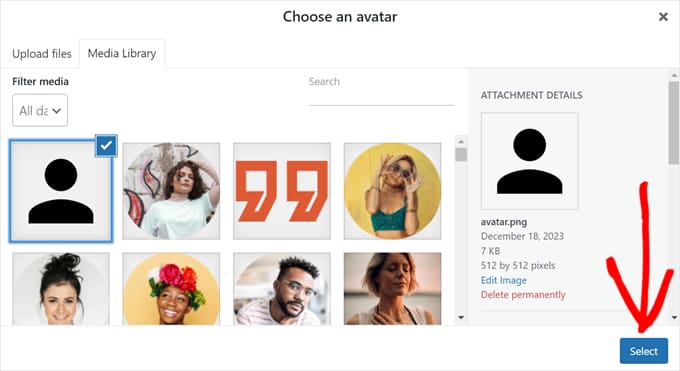
¡Y ya está!
Ahora deberías ver tu nueva foto de perfil de gravatar por defecto en la vista previa y en tu sección de comentarios en directo.
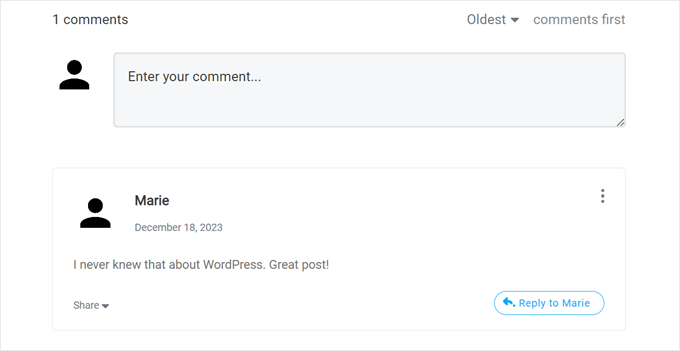
Lo mejor acerca de Thrive Comments es que puede fácilmente diferida gravatars carga con él.
Esto significa que WordPress no mostrará el gravatar de un comentarista hasta que el visitante del sitio web se desplace hacia abajo hasta ese comentario en concreto.
Si quieres activar esta característica, simplemente ve a Thrive Escritorio “ Thrive Comments y abre la pestaña ‘Ajustes Avanzados’. Luego, marca la casilla que dice ‘Cargar imágenes de avatar cuando el comentario entre en el área visible’.
También puedes marcar las otras características de la carga diferida.
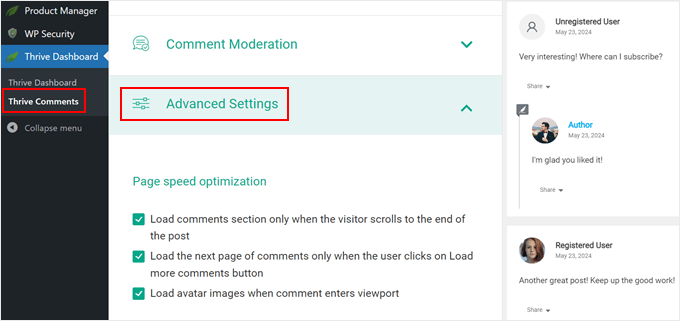
Para más consejos y trucos sobre el uso de Thrive Comments, marca / comprueba estas guías:
- Cómo destacar o enterrar comentarios en WordPress
- Cómo redirigir la atención del usuario con la redirección de comentarios
- Cómo eliminar el campo URL del sitio web del formulario de comentarios de WordPress
Método 3: Insertar un fragmento de código para utilizar un Gravatar personalizado (Método de código)
Además de utilizar Thrive Comments, también puedes subir un gravatar personalizado utilizando un código. Usted puede preferir este método si simplemente desea añadir una nueva imagen a la lista de gravatar en la página de discusión de WordPress.
Como en el segundo método, necesitas tener una imagen que quieras usar como gravatar.
Después, puedes subir la imagen a tu sitio de WordPress yendo a Medios ” Añadir nuevo. Aquí puede elegir una imagen de la biblioteca de medios de WordPress o subir un archivo nuevo desde su ordenador.
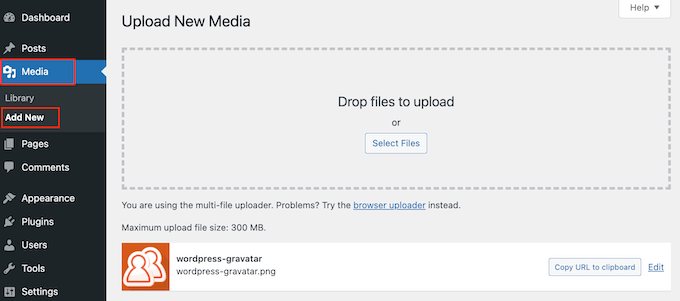
Una vez elegida la imagen, haz clic en el enlace “Editar” situado a su lado.
WordPress abrirá el archivo para editarlo. En esta pantalla, desplácese hasta la sección “URL del archivo“.
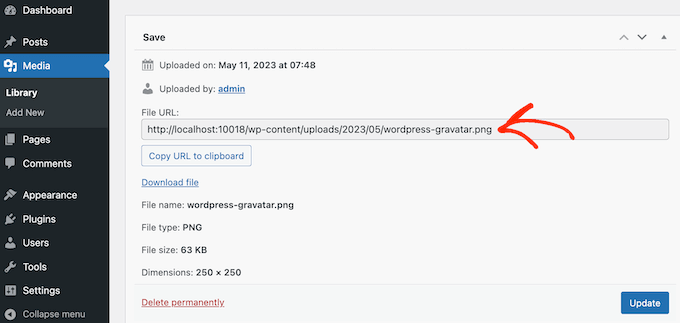
Anote esta URL, ya que la necesitará en el paso siguiente.
En esta fase, debe añadir código a su sitio de WordPress. A menudo, los tutoriales le pedirán que añada fragmentos de código personalizados al archivo functions.php de su tema.
Sin embargo, no se lo recomendamos porque incluso un pequeño error en su código puede provocar errores comunes de WordPress o romper completamente su sitio web.
Por eso recomendamos usar WPCode. Es la forma más fácil y segura de añadir código personalizado en WordPress sin tener que editar ningún archivo del núcleo de WordPress.
Lo primero que tienes que hacer es instalar y activar el plugin gratuito WPCode. Para más detalles, consulta nuestra guía paso a paso sobre cómo instalar un plugin de WordPress.
Una vez activado, vaya a Fragmentos de código “ Añadir fragmento en su escritorio de WordPress.
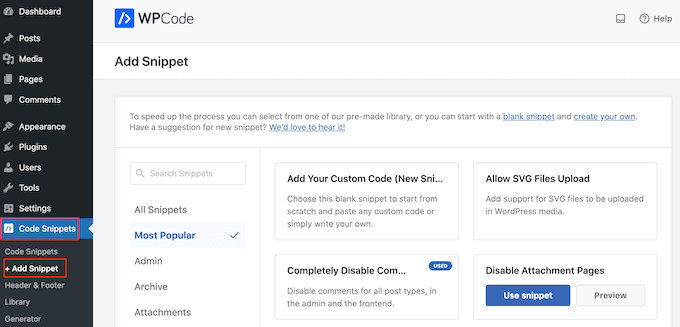
Aquí verás todos los fragmentos de código que puedes añadir a tu sitio web de WordPress. Estos incluyen fragmentos de código que le permiten desactivar completamente los comentarios en WordPress, subir archivos SVG a su sitio, y mucho más.
Incluso hay uno para utilizar una imagen personalizada como avatar predeterminado. Simplemente busca el fragmento ‘Custom Default Avatar’ en la biblioteca.
Cuando lo encuentres, pasa el ratón por encima y haz clic en el botón “Usar fragmento”.
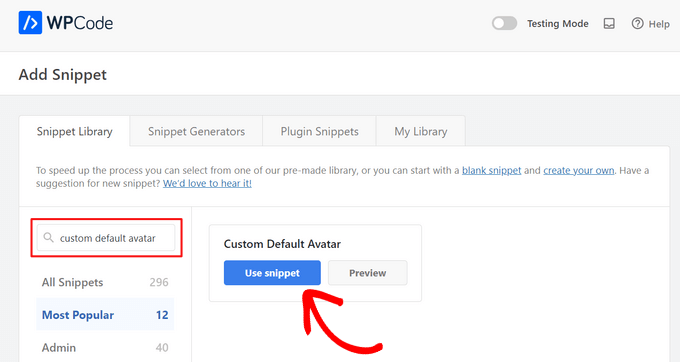
Después de eso, WPCode añadirá automáticamente el código correcto para usted.
No olvide reemplazar la URL con un enlace a la imagen que desea utilizar como gravatar por defecto de WordPress.
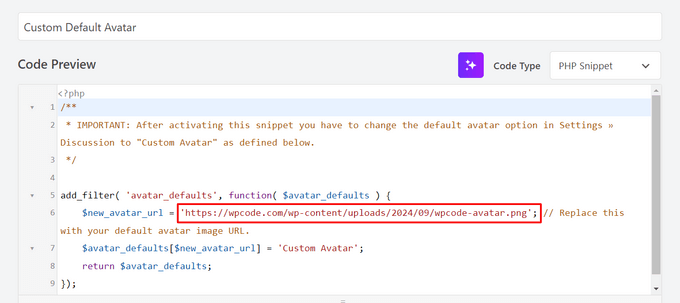
Debajo del cuadro de código, verá algunas opciones de inserción. Si aún no está seleccionada, elija el método ‘Auto Insertar’ para que el fragmento de código se inserte y ejecute automáticamente en todo su sitio.
A continuación, abre el menú desplegable “Ubicación” y haz clic en “Ejecutar en todas partes”.
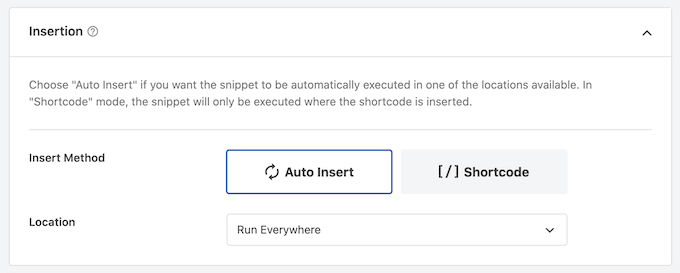
Una vez hecho esto, hay que desplazarse a la parte superior de la pantalla y hacer clic en el conmutador “Inactivo” para que cambie a “Activo”.
Por último, haz clic en “Actualizar” para activar el fragmento de código de gravatar.
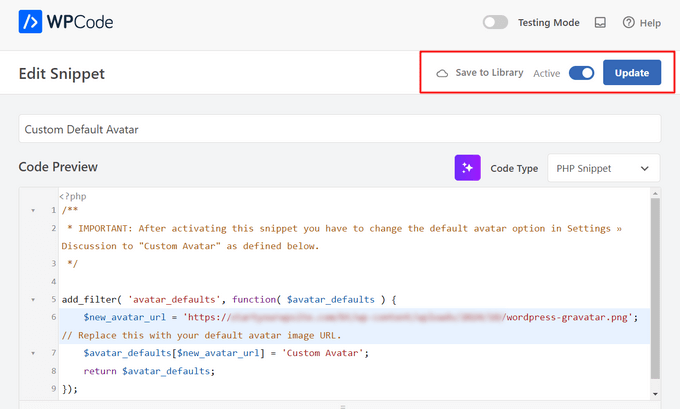
Para empezar a utilizar este gravatar, ve a la página Ajustes ” Discusión.
En la sección “Avatar predeterminado”, seleccione la nueva opción “Avatar personalizado”.
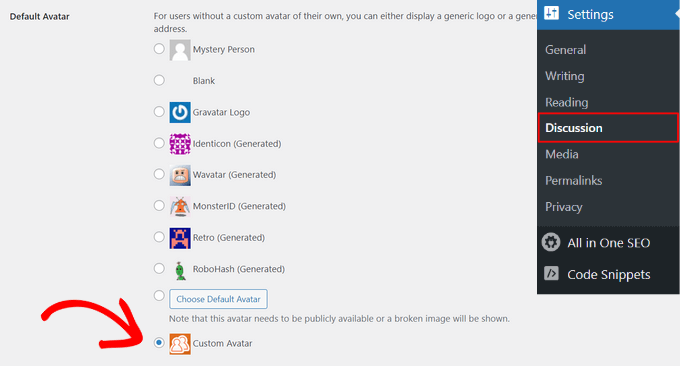
Después, asegúrate de hacer clic en “Guardar cambios” para establecer los ajustes.
Ahora, si visitas tu sitio web, verás la nueva imagen de gravatar por defecto en directo.
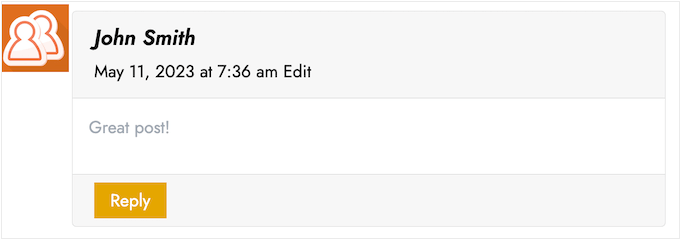
Ya está. Para aprender más acerca de gravatars en WordPress, marca / comprueba estas guías:
- Cómo mostrar Gravatar desde el correo electrónico del usuario en WordPress
- Cómo desactivar los Gravatars en WordPress (paso a paso)
- Cómo cambiar el tamaño de la imagen de Gravatar en WordPress
Esperamos que este artículo te haya ayudado a aprender cómo cambiar el gravatar por defecto en WordPress. Puede que también quieras ver nuestra guía sobre cómo moderar comentarios en WordPress y nuestro listado de los mejores plugins de comentarios para WordPress.
If you liked this article, then please subscribe to our YouTube Channel for WordPress video tutorials. You can also find us on Twitter and Facebook.





anna
Thanks for the nice explanation, Now I’m clear about setting up my gravatar in WordPress site.
rashmi
this is very useful
Pat
Thank you, thank you, thank you! I’ve looked everywhere on how to change the default avatar and you were the only ones who simple explained it and displayed how! Sometimes finding the answer in the haystack of information can be just mind blowing. You rock!
manoj rai
how set when user comment your post show him/her original profile. please help me. thanks
Joy
Hello, I’ve tried this in my child’s theme function and it just will not work. The image in the discussion settings and on the front-end appear broken. When I right click to view the path it displays:
It affixes the i1.wp.com before the link. Even when I tried to connect directly to the child theme stylesheet directory and pickup from the folder, ‘images/chicken_avatar.png’, it still affixed the i1.wp.com
Any ideas how to fix this? Thank you.
WPBeginner Support
Hey Joy,
We tested it again with a child theme and it worked as expected. We are not sure what may be causing the issue. You can follow the instructions again. Make sure you add the full image URL in the code.
Admin
Joy
Hmm, not sure what I was doing wrong. I just gave it another go and it works. Thank you!
Andrew
Joy: Mine Via Another WordPress Script, is Going to (i0.wp.com/MySite…). Very Strange. :–)
Andrew
It Still Shows i0.wp.com/MySite Whwn Going to the Image Location, but I Changed the URL Code to (‘/custom-gravatar/mh-profile-photo-default.png’), Instead of ‘example.com/wp-content/uploads/2017/09/mh-profile-photo-default.png’). In Settings > Discussion It Shows My Admin Photo as the Default User Gravatar, but On User Profiles, It Views Properly! :–)
Mayaprakash Pant
Hello.
The code worked perfectly fine for me. But this arises another problem:
Same gravatar appears when everyone else including visitor comments on my blog.
How to solve this?
Gabrielle
Hi, i added and sucesfully saved input(type = url) for each user profile, on ly localhost installation.
I’m trying to change original code from WP Codex wesbsite:
From:
add_filter( ‘avatar_defaults’, ‘new_default_avatar’ );
function new_default_avatar ( $avatar_defaults ) {
//Set the URL where the image file for your avatar is located
$new_avatar_url = get_bloginfo( ‘template_directory’ ) . ‘/images/new_default_avatar.png’;
//Set the text that will appear to the right of your avatar in Settings>>Discussion
$avatar_defaults[$new_avatar_url] = ‘Your New Default Avatar’;
return $avatar_defaults;
}
To something that will replace default avatar url foreach user with value from custom input field(if its not empty), any help?
I know there are plugins that allows subsciribers to upload gravatar images, but i don’t want to allow them doing that, i want to give them a chance to put url to their own images
Manish B
I am not able to show avatars next to comments. I am using Hitchcock WordPress Theme.
Claire Benneth
THANK YOU!
Actually I’ve been looking for this solution for my blog for 3 months!
Thanks again!
Claire xo
Jen Hardy
I have the Gravatar set up in WordPress, but when the e-mail goes out to my followers for my blog, the mystery man is there. Looks really bad at the top of my e-mail. Any suggestions?
Thanks!
Syed Hamza
Here are two folders of images in Cpanel.
1. /public_html/wp-includes/images
2. /public_html/wp-content/themes/divi/images
In which folder where I upload the image.
Manoj
I can’t see my avatar even after setting in comment box but i see it about me.
Manish B
I am facing the same issue.
Michael
I’m looking for a plugin, or SIMPLE code solution that will allow me to create a number of ‘default’ gravatar/avatar images that are color coded based on the member’s gender/orientation. Obvious ones like blue for male, pink for female, but I’ll likely add lavender for transgender and possibly others. Basically, the decision about the ‘default’ avatar that appears for the member (until they upload an image) would at least let people browsing the site know if the person they see posting (or online) is male / female / transgender / etc.. Any ideas?
Me
Is there code to force the default avatar to be blank? I have it set to blank in the WP settings, but it’s still showing up as mystery man. Is there code to either delete mystery man entirely so it’s not even an option. Or to make sure it’s blank and not mystery man? Thanks!
WPBeginner Support
See our guide how to disable gravatars in WordPress.
Admin
Me
Thanks! I tried that already. When I do that, the avatars also disappear from the author box (I’m using Starbox). I’m at a loss. I’ve even checked my WP tables, and it shows the default avatar is set to blank. I can’t figure out how to get rid of mystery man…
Michael
How would one go about rotating a set of images in that Gravatar thumbnail spot? Meaning: if I had 5 different images, to have them randomly appear for users without Gravatars, so there was a variation of the 5?
Angelica Costa
If anyone is facing issues with child themes, just use:
$myavatar = get_stylesheet_directory_uri().’/img/favicon.png’;
It works.
Mark
This was a life saver!
Julia
Great, thanks!
Gina Smith
Thanks for the information!
Keely
Wow – found this post 2 years after my first post and got it working this time
Thanks WP Beginner
Caroline
Thanks!
chris007
okay i get the whole idea but how you put your personal pciture of you into the gravatar that what i’m trying to figure out..
Thomas
Goto Gravatar website and sign in with WordPress. Then you can upload your avatar and tie it to one or more of your emails.
Alex
Thank you!
Karan Rawat
It works. Thanks Bookmarked your blog!
Chuks Emmanuel
Thank you Syed Balkhi. it really worked for me. just keep the good work going.
Adrian O'Farrell
Hi, just checking what happens next
Simen Eggen
Thank you so much it’s working
it’s working 
Sadia
Thank you so much for these instructions. For some reason, things were wonky when I used a .png file, but a gif worked easy peasy!
Katelyn
I am having the same issue as Keely. I am using a child theme so get_bloginfo does not work. When I check the URL of the broken image it displays the path to the parent theme. Is there a way to get this to work with a child theme?
Akash KB
What should be the size of the image file to be uploaded to the theme folder?
Thanks
Brody
Any way to make this use a SSL connection using the same code? Always loads “insecure content”. What changes to make it a secure image during loading?
WPBeginner Support
If you are loading gravatar on a secure page then it should automatically load securely. Also check Settings » General change your site and WordPress address to use https. Let us know if this solved the issue.
Admin
Pavan Deshpande
Thank you for sharing this , i was not able to change the default image but after reading this i changed
Keely
What if you’re using a child theme …
I changed the line
$myavatar = get_bloginfo(‘template_directory’) . ‘/images/gravataricon.gif’;
to
$myavatar = get_bloginfo(‘stylesheet_directory’) . ‘/images/gravataricon.gif’;
but still not working
Editorial Staff
Is the image not showing or the code altogether is not working (i.e it’s not even adding an option for custom gravatar)?
Admin
Kristen
I am having issues with the code also. I used it on another site and it worked perfectly, however on the site I’m currently working on… it shows as an option in the admin panel under settings-discussion, however it is showing as a broken image and does not display on the blog pages either. Any help is greatly appreciated.
Editorial Staff
Right click on the broken image to get the image URL. Open that URL in another tab to verify that the URL is correct.
Dizz Markie
I am having the same issues on localhost
Rachel
I just used your advice here; more explanation that the image needed to be saved in the themes folder too would have been helpful. But your tips here helped me figure some of it out. Thanks.
mrahmadawais
@wpbeginner Secondly , do you know an good pre image loading plugin for wordpress
mrahmadawais
@wpbeginner disquess is having some problems at my blog see there http://freakify.com it is not allowing me to upload any custom image>>>? Why
wpbeginner
@mrahmadawais That is because Disqus is a third party platform….
mrahmadawais
tell me plz
mrahmadawais
any one here now to tell me why disquss is not accpting this
Crysislevel
thanx it worked perfectly!
Shabil Team
This gravatar custom code is very cool and really work on my blog. Thank you very much.
You rock WPbeginner.
Shabil Team
This gravatar custom code is very cool and really work on my blog. Thank you very much.
You rock WPbeginner.
wpbeginner
@Kindar We are glad to have you as a user Let us know if you have any suggestions.
Let us know if you have any suggestions.
Kindar
When ever I search for something on the internet i usually get to see your website.. Now I started follow your website and the stuff you share.. What ever you share its really useful and thats why i always check it up, and see whats new. Also i wanted to thank you for the last subject.
Kindar
When ever I search for something on the internet i usually get to see your website.. Now I started follow your website and the stuff you share.. What ever you share its really useful and thats why i always check it up, and see whats new. Also i wanted to thank you for the last subject.
iur
where is located the file /images/gravataricon.gif ?
Editorial Staff
Inside your WordPress Theme’s folder.
Admin
Cee
Hi!
Wow..I’ve gone round and round with code. Not adept with this as a newb…but usually can get things to work.
I added the code to get a default avatar for guest . It worked. At least in admin. The image shows up in ADMIN..but not on the website.
I also signed up at gravatar for my own custom gravatar for my ADMIN comments…and it shows up in their “check point”…but cannot get it to show up in my comments.
Neither does the Guest Gravatar.. but the GRAVATAR image shows up instead.
My custom image IS checked as default in Discussions. Both images are uploaded to the theme/images and the path to the guest image is correct in the code. I made the images 128 x 128 as suggested online nowadaZe… Dunno if THAT sizing must be specified somewhere? I looked thru the functions code…as best as my bewildered eyes can comprehend..but didn’t finding anything that looked like it would work. Maybe in style.css?… Dunno if it makes a difference. Don’t want to go thru changing everything..and still not work. Have already spent DAYS trying to figure this out. Should be a simple thing.
Don’t understand why MY admin gravatar isn’t showing. Per what I read…it should be handled via gravatar. The email address used for the gravatar is the same as listed in admin.
WHAT am I doing wrong/missing?.. I have WP 2.8.4.
I tried pasting the above code at the top…AND at the bottom… but neither works. Does it matter WHERE you paste it in the functions.php?
Can you suggest anything?Would DEEPLY appreciate any help you can give. Can give you any code you might need…just specifiy.
Thank you in advance. tearing out hair..
Editorial Staff
It sounds like that this issue is not with the function rather it is the comments.php file error.
Admin
Louis Gubitosi
thanks for this tip. I used this on my site and the default avatar is showing up in the comments section but not in the “Recent Comments” side bar. I’m using the “Get Recent Comments” plugin. Is this treated differently?
http://interactiveblend.com/blog
Editorial Staff
Unless that plugin has specified a default in their code, this should work. It means the plugin is not coded properly. Contact the developer, and ask them to fix it.
Admin
martin
The code works if placed in custom-php.php which has the advantage of sticking through upgrades.
Do you have any ideas on the code for removing the html calls to gravitar.com in buddypress?
JD
Thanks for the tip. Works flawlessly.
Desik
I noticed wordpress is changing the quote into a backquote, you should use
'instead of’Editorial Staff
Problem fixed.
Admin
fantasmo
This is the code snippet I was looking for.
But it doesn’t work properly… I put in the code into my functions.php (I’m sure everything is correct, also the path to my picture).
But when I go to discussion, I can’t see my Avatar, and also the WP-backend is a little bit broken… The code i put into the functions.php shows up above the header of the WP-backend.
Can you help me please? Maybe I didn’t only a little thing wrong??
Editorial Staff
The code above is 100% correct because that is what we are using. I don’t know what you can potentially be doing wrong. But without looking at your codes we won’t be able to help you out. You can hire us for a small fee, and our staff can surely fix the problem.
Admin
Tracy
I think I may be having the same trouble as fantasmo. The snippet works and the gravatar shows up within the discussion admin page but when you click on ‘save changes’ to save the options, you get a white screen which displays the footer from the option-discussions.php instead of the full page saying that the options have been saved.
CC Rogers
I saw the same results as Fantasmo. When I copy/pasted the code, the blank line between the add_filter and the function was lost for some reason. Putting the blank line back seemed to fix the problem.